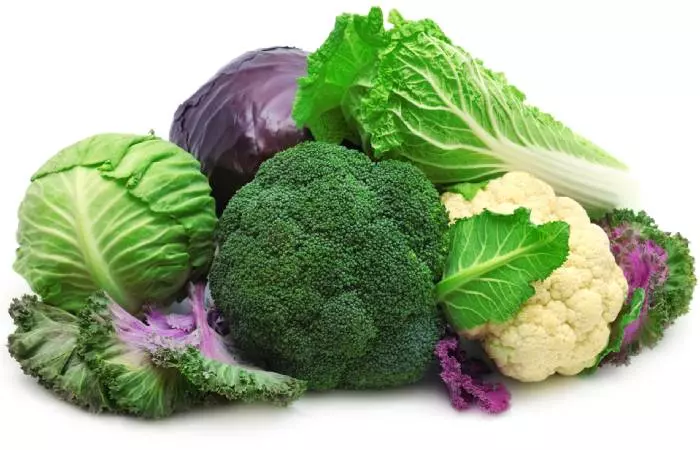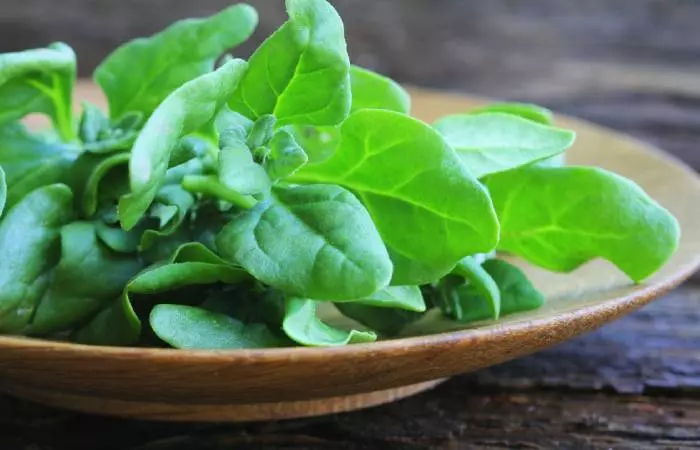What Are Oxalates?
Oxalates are naturally occurring compounds found in vegetables, fruits, grains, and nuts (1). They are also produced as a waste product by the human body in small amounts. Oxalates are formed when oxalic acid, a substance present in leafy greens and fruits, binds with minerals like calcium (2). These crystals have the potential to accumulate in the kidney, leading to a painful condition called Nephrolithiasisi Medical condition characterized by the formation of small, hard mineral deposits or stones in the kidney or urinary tract. (or kidney stones). These are common in people who excrete urine that contains high amounts (above 25 mg/day) of crystal-forming substances like oxalates, uric acid, and calcium (1), (3). Therefore, managing oxalate intake through dietary restrictions is essential for those who are prone to kidney stone formation.
What Is A Low-Oxalate Diet?
A low-oxalate diet is a dietary approach that limits the consumption of foods rich in oxalates, naturally occurring substances found in plant-based foods. This diet aims to lower oxalate levels in the body, especially in the urine, to lessen the chance of kidney stone development and also ease symptoms brought on by disorders such as hyperoxaluriai A medical condition caused by disordered oxalate metabolism, leading to elevated oxalate levels in urine and kidney stone formation. (1). Doctors often recommend moderate consumption of calcium and a low intake of oxalate to prevent the formation of calcium oxalate stones (4). Generally, a low-oxalate diet is meant to limit the oxalate intake between 40- 50mg per day (5). Apart from that, staying hydrated and limiting protein intake are also two other important aspects one needs to follow when trying to adhere to this diet. It may take 3-6 weeks of following this diet to see an improvement in symptoms. However, the duration may vary depending on the severity of the condition. Now that we know exactly what a low-oxalate diet is, it’s important to understand the benefits of a low-oxalate diet. Keep reading!
Benefits Of A Low-Oxalate Diet
A low-oxalate diet offers several potential health benefits:
1. May Reduce Urine Oxalate Levels
One major reason to follow a low-oxalate diet is to prevent kidney stones. High oxalate levels can lead to the formation of painful calcium oxalate crystals in the kidneys. Studies show that reducing oxalate intake in your diet can lower oxalate levels in your urine, reducing the risk of kidney stone formation (1).
2. Prevents Recurrence Of Kidney Stones
The risk of kidney stone recurrence is between 30-50% (as per observational studies). Therefore, other than necessary precautions, a diet adequate in calcium and low in oxalate can provide symptomatic relief and prevent the recurrence of kidney stones or nephrolithiasis (7).
3. May Improve Symptoms Associated With Autism
Studies found that children with autismi Also called autism spectrum disorder, is a complex developmental disorder that affects learning, communication, behavior, and interaction. have higher concentrations of oxalate in their bodies due to impaired renal excretion, which means that they are unable to eliminate oxalate properly from their bodies (8). No proper evidence seems to suggest that a high oxalate diet is related to autism. However, some dietary restrictions and changes towards maintaining a low-oxalate level may help manage hyperoxaluria (oxalate metabolism disorder) and other co-occurring symptoms like gastrointestinal issues in people with autism, as they often have disordered eating behavior (9).
4. May Prevent Cystic Fibrosis Complications
People with cystic fibrosisi A genetic disease where the production of thick mucus affects the lungs, digestive system, and other organs in the body. are at a greater risk of developing nephrolithiasis and hyperoxaluria, which may affect renal function. Studies have shown a higher prevalence of increased oxalate levels in the urine of people with cystic fibrosis (10), (11). Therefore, a low-oxalate diet may help manage and prevent cystic fibrosis complications.
5. May Help Treat Vulvodynia
Vulvodyniai Chronic pain condition characterized by persistent, unexplained discomfort or pain in the vulva, an external genital area of the female reproductive system. is a condition which is characterized by irritation, discomfort, and pain around the vagina. The exact cause of vulvodynia may not be clear, but some studies suggest that a diet low in oxalate can help reduce oxalate concentration in urine and help manage the pain related to vulvodynia (12). There are many benefits of a low-oxalate diet as we discussed, so now let’s move on to understand which food items to avoid and eat on a low-oxalate diet.
Foods To Eat On A Low-Oxalate Diet
Here’s a list of foods that you can eat on a low-oxalate diet (13):
Foods To Avoid On A Low-Oxalate Diet
Here’s a list of high-oxalate foods that you should be cautious about (13), (15), (16): The list is not exhaustive. You can check out more oxalate foods you may want to avoid or limit while on this diet. However, before eliminating these foods and considering a low-oxalate diet, understanding potential risks and side effects is crucial. Let’s learn more about the potential risks of this plan!
Side Effects Of A Low-Oxalate Diet
Apart from these, adhering to a low-oxalate diet can be socially challenging, as it requires avoiding many common foods at social gatherings, restaurants, and events. This restriction can affect one’s quality of life and social interactions.
Conclusion
A low-oxalate diet can offer many health benefits. It is quite similar to the kidney stone diet and may help manage kidney stones and oxalate-related health conditions. People can lower or alleviate related symptoms, and potentially enhance their overall health through mindful food selection and oxalate intake tracking. However, it’s crucial to strike a balance, as overly restrictive diets may lead to nutritional deficiencies and other health concerns. Therefore, seeking guidance from a healthcare professional or registered dietitian is essential to ensure that a low-oxalate diet is personalized, sustainable, and nutritionally sound. Is the low-oxalate diet suitable for everyone? No, a low-oxalate diet is not suitable for everyone. It is specifically for those struggling with medical conditions like kidney stones or hyperoxaluria. Can we follow a low-oxalate diet while traveling? Yes, it is possible to follow a Low-Oxalate Diet while traveling, but it requires some planning and flexibility. Researching restaurant menus, packing low-oxalate snacks, and communicating dietary needs to accommodations and dining establishments can help travelers while on the go. Is the low-oxalate diet the same as a low-oxalate supplement? No, they are not the same. The low-oxalate diet involves restricting the intake of high-oxalate foods, while a supplement typically provides calcium or other substances to bind with oxalates in the digestive tract, reducing their absorption. Can we get enough nutrients on a low-oxalate diet? Yes, it’s possible to get enough nutrients on a low-oxalate diet with careful planning. You need to strike a balance and may have to take supplements to minimize the risk of deficiencies. However, do not start the diet and take supplements without consulting a nutritionist or a registered dietitian. What are some common misconceptions about the low-oxalate diet? There are several misconceptions about the low-oxalate diet. People often think that all oxalates are harmful. In reality, some are essential for health. Another misconception is that the low-oxalate diet is for weight loss, while it is actually for managing kidney stones. People also think that while on this diet they have to exclude all high-oxalate foods. However, the truth is, that a few of them can be consumed in moderation. It’s all about striking a balance. In this insightful video, dive into the world of the low-oxalate diet and explore the science behind it, and the benefits and risks of embracing this dietary approach. Take a look.











